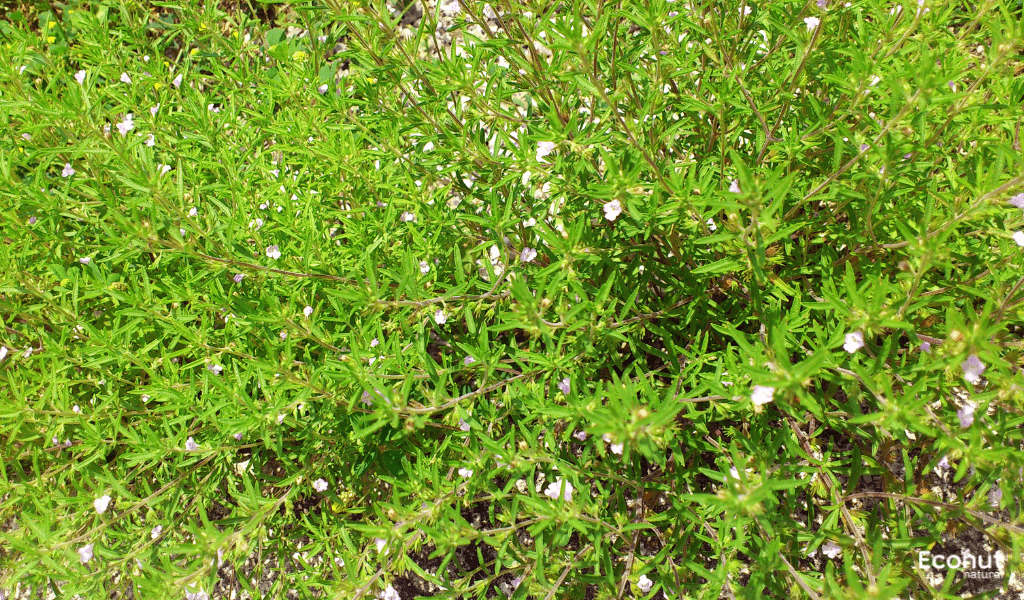Satureja hortensis (Summer savory) is a member of the Lamiaceae mint family. This herb is utilized medicinally in addition to being a wonderful spice. The herb is a taste enhancer in many different cuisines worldwide. Numerous medical conditions, including discomfort, diabetes, indigestion, sore throat, fever, cold, cough, and lack of cravings, can be helped by the plant.
Summer Savory is a delicious annual herb that blooms and has uses in cooking, medicine, aromatherapy, and decoration. It is frequently used to flavor soup, tea, vinegar, pork, cabbage, and butter. It has a somewhat spicy flavor. Additionally, potpourris employ it.
Description
The plant produces smooth, thin, dark green leaves. Juniper leaves are tender and delicate; they are used to make the sauce and to top roasted chicken. The plant achieves maturity in July, and in August it starts to bloom with gorgeous small white blooms.
Botanical Name:
Summer savory
Family:
Lamiaceae
Leaves:
The leaves of summer savory are the most easily recognized feature. Typically, they are lance-shaped, tiny, and narrow, with a length of 1-3 cm. The leaves have a smooth surface and have a deep green color. Along the stems, they are grouped in opposite pairs.
Flowers:
Little white to pale pink-violet blossoms grow in whorls around the upper portion of the stems of summer savory. Even though the summer blooms attract pollinators, the herb’s flavor is thought to be at its peak prior to flowering.
Roots:
The fibrous root structure of summer savory aids in its soil anchoring.
Stems:
Summer savory has slender, woody stems that have a square cross-section. The stems can reach a height of 30 cm and are usually branched.
Habitat:
Summer savory is commonly grown as a culinary herb and can be found from western Asia to southeast Europe. In Europe, it has also long been used as a medicinal herb. It is imported throughout most of northeastern North America, including New England, and may elude cultivation.
Parts Used:
- Flowers
- Leaves
- Seeds
Chemical Constituents
carvacrol, p-cymene, α-thujune, α-pinene, β-myrcene, β-terpinene, thymol, linalool, and β-caryophyllene are the main ingredients of this plant essential oil.
Other Language Names of Satureja hortensis (Summer savory)
French name – Sarriette
Italian name – Santoreggia, Santoreggia Domestica, Savoreggia
Spanish name – Ajedrea de Jardín, Ajedrea Blanca, Ajedrea Común (common savory)
German name – Bohnenkraut (bean herb)
Dutch name – Bonenkruid (bean herb)
Polish name – Cząber
Scientific Classification
| Kingdom | Plantae |
| Subkingdom | Tracheobionta |
| Superphylum | Spermatophyta |
| Phylum | Magnoliopsida |
| Class | Magnoliopsida |
| Subclass | Lamioideae |
| Order | Lamiales |
| Family | Lamiaceae |
Satureja hortensis (summer savory) uses
- Summer savory essential oil offers potent anti-inflammatory properties that help arthritis sufferers with their joint discomfort by lowering joint inflammation. Additionally, it lessens muscle soreness and edema.
- In addition to treating internal health issues, the tea made from summer savory leaves helps guard against colic, urine retention, and uterine contractions. The herb’s antibacterial qualities aid in improved liver and kidney function.
- The herb can also be used to treat wounds, skin infections, and sore throats.
- Summer savory leaf tea can be used to prevent colic, urine retention, and uterine contractions in addition to treating internal health issues. Better liver and kidney function is facilitated by the herb’s antibacterial properties.
Satureja hortensis (summer savory) Benefits
Eases Pain:
Studies reveal that a few species of the Satureja hortensis (Summer savory) plant genus possess analgesic and anti-inflammatory characteristics. Summer savory has been used as a traditional folk remedy for bone discomfort.
Good for Low-Sodium Diet:
It is reported that the Romans used summer savory in place of salt when cooking. It has a powerful scent and a beautifully savory flavor with hints of acidic, peppery, and salty notes.
Offers Helpful Compounds:
A variety of bioactive substances, including as tannins, phenolic compounds, and flavonoids, make up summer savory. Terpenes, which give the herb its distinct flavor, aroma, and medicinal properties, are also provided by it.
Satureja hortensis (summer savory) Side Effects
Digestive Issues:
When consumed in large quantities, summer savory can result in nausea, diarrhea, heartburn, and upset stomach.
Bleeding Problems:
Summer savory might slow down blood clotting, increasing your risk of bleeding, especially if you take blood-thinning medications
Skin Irritation:
Summer savory oil that is concentrated and undiluted is highly irritating and ought to be avoided. When applied topically, diluted oil is usually harmless, but before using it on any skin issues, gets medical advice.
Pregnancy and Breastfeeding:
The safety of summer savory during pregnancy or nursing is not well enough documented. In these situations, it’s advisable to steer clear of it completely.
Read Also: Angurshafa, Soochi, (Atropa belladonna) – Properties, Uses, Benefits & Side Effects
Conclusion
Satureja hortensis (Summer savory) is a plant. The stem and leaves are used to make medicine. Summer savory is used to treat a variety of ailments, including diarrhea, vomiting, gas (flatulence), coughing, and loss of appetite, however these claims are not well supported by research. Summer savory is used as a culinary spice in dishes.
FAQS
What is Satureja hortensis herb used for?
Medicine is made from the stem and leaves. Summer savory is used to treat a variety of ailments, including diarrhea, vomiting, gas (flatulence), coughing, and loss of appetite, however these claims are not well supported by research. Summer savory is used as a culinary spice in dishes.
What are the health benefits of Satureja hortensis (Summer savory)?
Summer savory is used to treat digestive issues such as cramps, indigestion, gas, diarrhea, nausea, and loss of appetite, as well as coughs and sore throats. It is taken by diabetics to quench frequent thirst. In order to boost sex drive, it is also used as an aphrodisiac and tonic.
What are the side effects of summer savory?
Savory summer foods may reduce blood coagulation. Bleeding and bruises may occur more frequently if summer savory is taken with drugs that also inhibit blood coagulation.

